Comparative Investigation on the Ablation of Uncoated and Coated Mild Steel Inflicted by the 2 ms 2 kA Rectangular Current
Abstract
:1. Introduction
2. Materials and Methods
2.1. Materials
2.2. Ablation Test Methods
2.3. Characterization Methods
3. Results
3.1. Macro-Morphology of the Ablation Zone
3.1.1. Uncoated Plate
3.1.2. Coated Plate
3.2. Microstructure and EBSD Analysis
3.2.1. Microstructure
3.2.2. EBSD Analysis
3.3. Vickers Hardness
4. Discussion
4.1. Geometry of the Ablated Zones
4.2. The Microstructure and Vickers Hardness in the Ablated Zones
5. Conclusions
- The energy density, which was injected from the arc of 2 ms rectangular current with 2 kA amplitude to the test plate, exceeded 106 W/cm2. Being struck by the arc, the steel in the uncoated and coated plates both melted instantaneously within 2 ms and then solidified rapidly, which resulted in the ablated zone.
- The coating constricted the splashing effect of steel melt, which was attributed to the explosive force induced by the thermal gradient at the arc attachment point on uncoated plate and confined the arc root in the ablated crater. Thus, the section of the ablated zone is band-shaped in uncoated plate and is crescent-shaped instead in coated plate. The width–depth ratios of the ablated zones in uncoated and coated plates were 43.7 and 7.5, respectively.
- The ablated zones of uncoated and coated plates were both characterized by the quenched martensite mixed with a handful of ferrite, the fined grains and the increased Vickers hardness, as with the cases in surface re-melting treatment of steel via laser or pulsed-electron beam. And, there was no crack both in the ablated zone of uncoated and coated plates.
- For the uncoated plate, equiaxed grains were found both in the FZ and HAZ. For the coated plate, equiaxed grains were found in the HAZ, and coarser columnar grains mixed with smaller equiaxed grains in the FZ. This was attributed to that the coating influenced the steel melt’s geometry and dynamic behavior on the plate surface, which consequently altered the solidification process of the steel melt.
- In the HAZ of uncoated plate, the average Vickers hardness of steel increased by 113%, while, in the HAZ and FZ of the coated plate, it increased by 209% and 136%, respectively. The Vickers hardness profiles of the uncoated and coated plates both decreased monotonically from the ablated zone to the steel substrate.
Author Contributions
Funding
Acknowledgments
Conflicts of Interest
References
- Renni, E.; Krausmann, E.; Cozzani, V. Industrial accidents triggered by lightning. J. Hazard. Mater. 2010, 184, 42–49. [Google Scholar] [CrossRef] [PubMed]
- Chang, J.L.; Lin, C.C. A study of storage tank accidents. J. Loss Prev. Process Ind. 2006, 19, 51–59. [Google Scholar] [CrossRef]
- Wu, D.Y.; Chen, Z. Quantitative risk assessment of fire accidents of large-scale oil tanks triggered by lightning. Eng. Fail. Anal. 2016, 63, 172–181. [Google Scholar] [CrossRef]
- Necci, A.; Argenti, F.; Landucci, G.; Cozzani, V. Accident scenarios triggered by lightning strike on atmospheric storage tanks. Reliab. Eng. Syst. Saf. 2014, 127, 30–46. [Google Scholar] [CrossRef]
- McEachron, K.B.; Hagenguth, J.H. Effect of Lightning on Thin Metal Surfaces. Trans. Am. Inst. Electr. Eng. 1942, 61, 559–564. [Google Scholar] [CrossRef]
- Kern, A.; Zischank, W. Melting effects on metal sheets and air termination wires. In Proceedings of the 19th International Conference on Lightning Protection, Graz, Austria, 25–29 April 1988. [Google Scholar]
- Fisher, R.J.; Schnetzer, G.H. Damage to Metallic Samples Produced by Measured Lightning Currents. Technical Report from NASA; 1991; pp. 1–10. Available online: https://ntrs.nasa.gov/search.jsp?R=19910023326 (accessed on 3 October 2018).
- Zischank, W.; Drumm, F. Reliable simulation of metal surface penetration by lightning continuing currents. In Proceedings of the 18th International Aerospace and Ground Conference on Lightning and Static Electricity, Williamsburg, VA, USA, 26–28 September 1995. [Google Scholar]
- Kostogorovabeller, Y. Physics of Interaction of Lightning Currents with Aluminum Sheets. J. Aircr. 2012, 49, 66–75. [Google Scholar] [CrossRef]
- Chemartin, L.; Lalande, P.; Peyrou, B.; Chazottes, A.; Elias, P.Q.; Delalondre, C. Direct effects of lightning on aircraft structure: Analysis of the thermal, electrical and mechanical constraints. Aerosp. Lab. 2012, 5, 1–15. [Google Scholar]
- Moupfouma, F. Aircraft Structure Paint Thickness and Lightning Swept Stroke Damages. SAE Int. J. Aerosp. 2013, 6, 392–398. [Google Scholar] [CrossRef]
- SAE Aerospace Recommended Practice 5412B—Aircraft Lightning Environment and Related Test Waveforms; Society of Automotive Engineers: Warrendale, PA, USA, 2013.
- Yan, J.; Gao, M.; Zeng, X.Y. Study on microstructure and mechanical properties of 304 stainless steel joints by TIG, laser and laser-TIG hybrid welding. Opt. Lasers Eng. 2010, 48, 512–517. [Google Scholar] [CrossRef]
- Syed, B.; Shariff, S.M.; Padmanabham, G.; Lenka, S.; Bhattacharya, B.; Kundu, S. Influence of laser surface hardened layer on mechanical properties of reengineered low carbon steel sheet. Mater. Sci. Eng. A 2017, 685, 168–177. [Google Scholar] [CrossRef]
- Lan, L.Y.; Qiu, C.L.; Zhao, D.W.; Gao, X.H.; Du, L.X. Analysis of microstructural variation and mechanical behaviors in submerged arc welded joint of high strength low carbon bainitic steel. Mater. Sci. Eng. A 2012, 558, 592–601. [Google Scholar] [CrossRef]
- Proskurovsky, D.I.; Rotshtein, V.P.; Ozur, G.E.; Markov, A.B.; Nazarov, D.S. Pulsed electron-beam technology for surface modification of metallic materials. J. Vac. Sci. Technol. A 1998, 16, 2480–2488. [Google Scholar] [CrossRef]
- Gou, J.; Tang, Y.; Liang, F.; Zhao, Z.; Firsich, D.; Fielding, J. Carbon nanofiber paper for lightning strike protection of composite materials. Compos. Part B Eng. 2010, 41, 192–198. [Google Scholar] [CrossRef]
- Duan, L. Thecrystallization Kinetic and Thermal Decomposition Behavior of Polyurethane. Master’s Thesis, Nanjing University of Science and Technology, Nanjing, China, 2012. (In Chinese). [Google Scholar]
- Lin, M.L.; Eagar, T.W. Pressures produced by gas tungsten arcs. Metall. Trans. B 1986, 17, 601–607. [Google Scholar] [CrossRef]
- Hiraoka, K.; Okada, A.; Inagaki, M. Effect of electrode geometry on maximum arc pressure in gas tungsten arc welding. Q. J. Jpn. Weld. Soc. 1985, 3, 246–252. [Google Scholar] [CrossRef]
- Meng, X.M.; Qin, G.L.; Zou, Z.D. Sensitivity of driving forces on molten pool behavior and defect formation in high-speed gas tungsten arc welding. Int. J. Heat Mass Transf. 2017, 107, 1119–1128. [Google Scholar] [CrossRef]
- Liu, J.L.; Zou, Z.R.; Su, B.R. Heat Process Treatment with High Energy Beam, 1st ed.; Machinery Industry Press: Beijing, China, 1997; pp. 80–110. [Google Scholar]
- Shao, T.M.; Lin, X.C.; Yuan, W.D. Microstructure of transition zone in 2Cr14 steel by laser surface remelting. Acta Metall. Sin. 2001, 37, 1040–1044. [Google Scholar] [CrossRef]
- Liu, Z.J.; Han, L.J.; Jiang, X.L.; Le, X.Y. Study on microstructures of pulsed electron beam remelted carbon steel 45. J. Aeronaut. Mater. 2005, 25, 20–24. [Google Scholar] [CrossRef]
- Tang, G.Z.; Luo, D.; Tang, S.W.; Mu, Q.; Wang, L.Q. The microstructure and properties of Cr alloying layer after surface alloying treatment induced by high current pulsed electron beam. J. Alloys Compd. 2017, 714, 96–103. [Google Scholar] [CrossRef]
- Cui, Z.Q.; Qin, Y.C. Metalogy and Heat Treatment, 2nd ed.; China Machine Press: Beijing, China, 2007; p. 210. [Google Scholar]
- Zhao, Y.G.; Zhang, J.T.; Tan, J.; Ma, B.D. Microstructure Refinement and Property improvement of Metastable Austenitic Manganese Steel Induced by Electropulsing. J. Iron Steel Res. Int. 2014, 21, 685–689. [Google Scholar] [CrossRef]
- Zou, J.X.; Grosdidier, T.; Bolle, B.; Zhang, K.M.; Dong, C. Texture and Microstructure at the Surface of an AISI D2 Steel Treated by High Current Pulsed Electron Beam. Metall. Meter. Trans. A 2007, 38, 2061–2071. [Google Scholar] [CrossRef]
- Guan, Q.F.; Yang, P.L.; Zou, H. Nano crystalline and Amorphous Surface Structure of 0.45%C Steel Produced by High Current Pulsed Electron Beam. J. Mater. Sci. 2006, 41, 479–483. [Google Scholar] [CrossRef]
- Hao, S.Z.; Gao, B.; Wu, A.M. Surface Modification of Steels and Magnesium Alloy by High Current Pulsed Electron Beam. Nucl. Instrum. Methods Phys. Res. B 2005, 240, 646–652. [Google Scholar] [CrossRef]
- Proskurovsky, D.I.; Rotshtein, V.P.; Ozur, G.E.; Ivanov, Y.F.; Markov, A.B. Physical Foundations for Surface Treatment of Materials with Low Energy, High Current Electron Beams. Surf. Coat. Technol. 2000, 125, 49–56. [Google Scholar] [CrossRef]
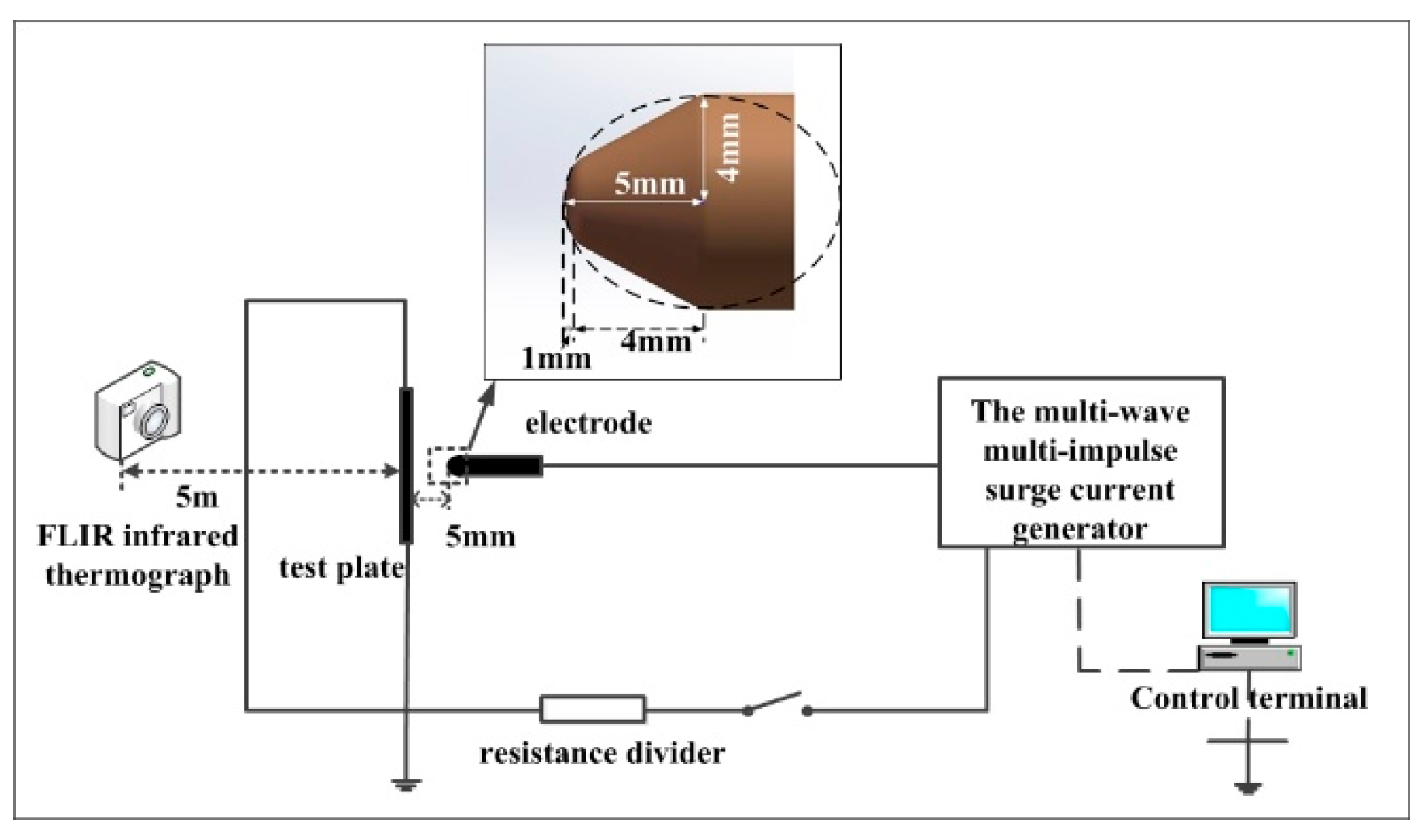
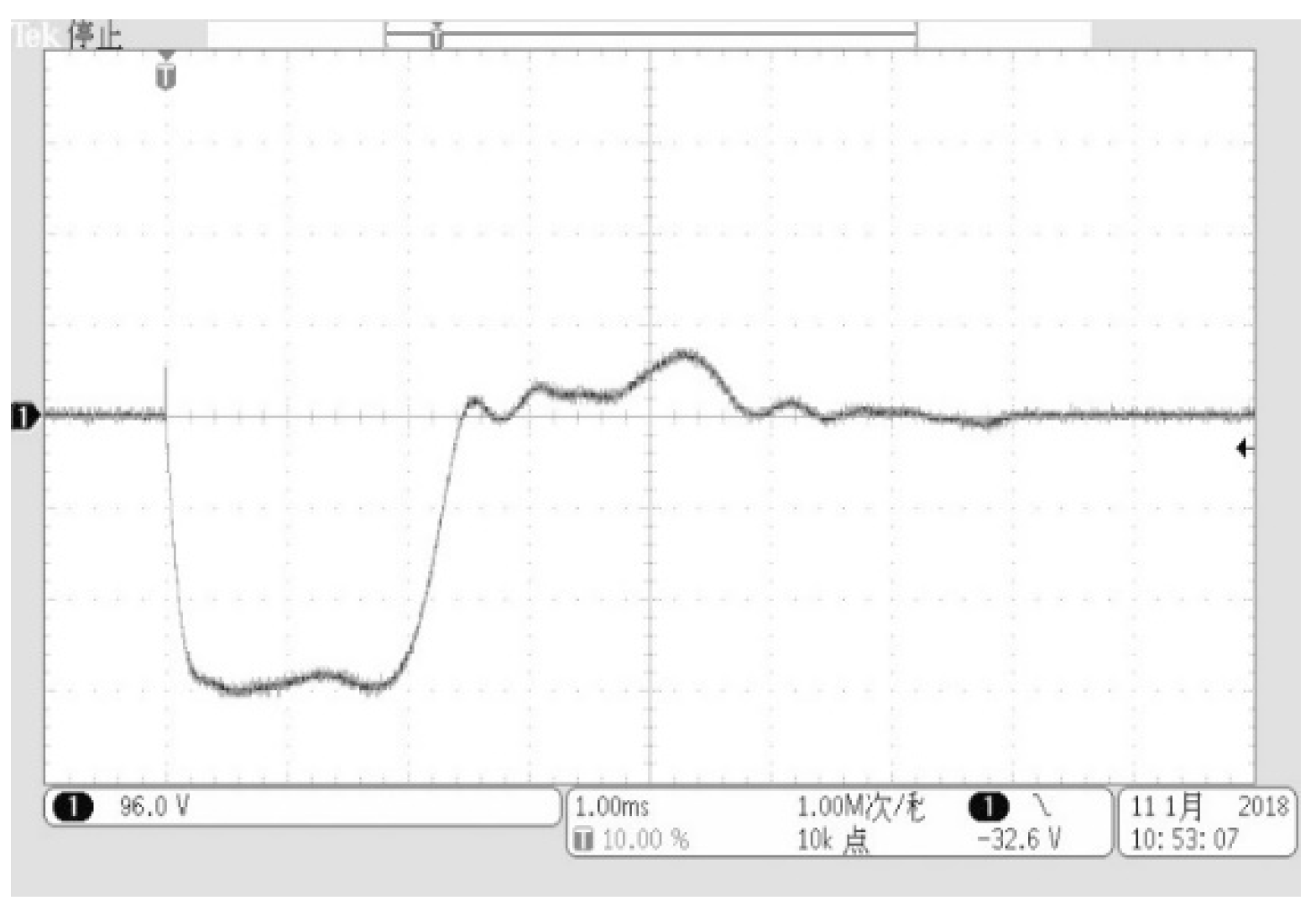


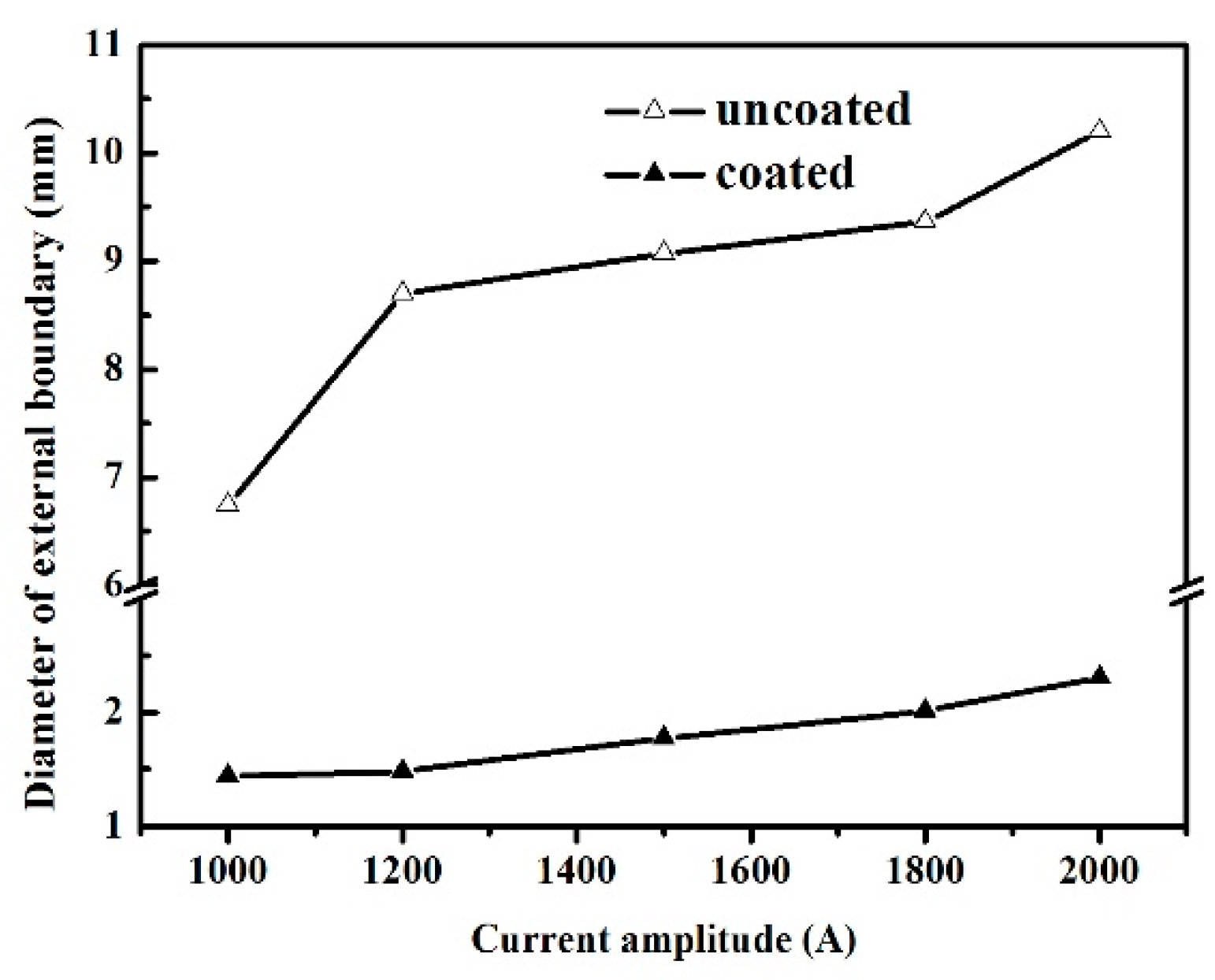
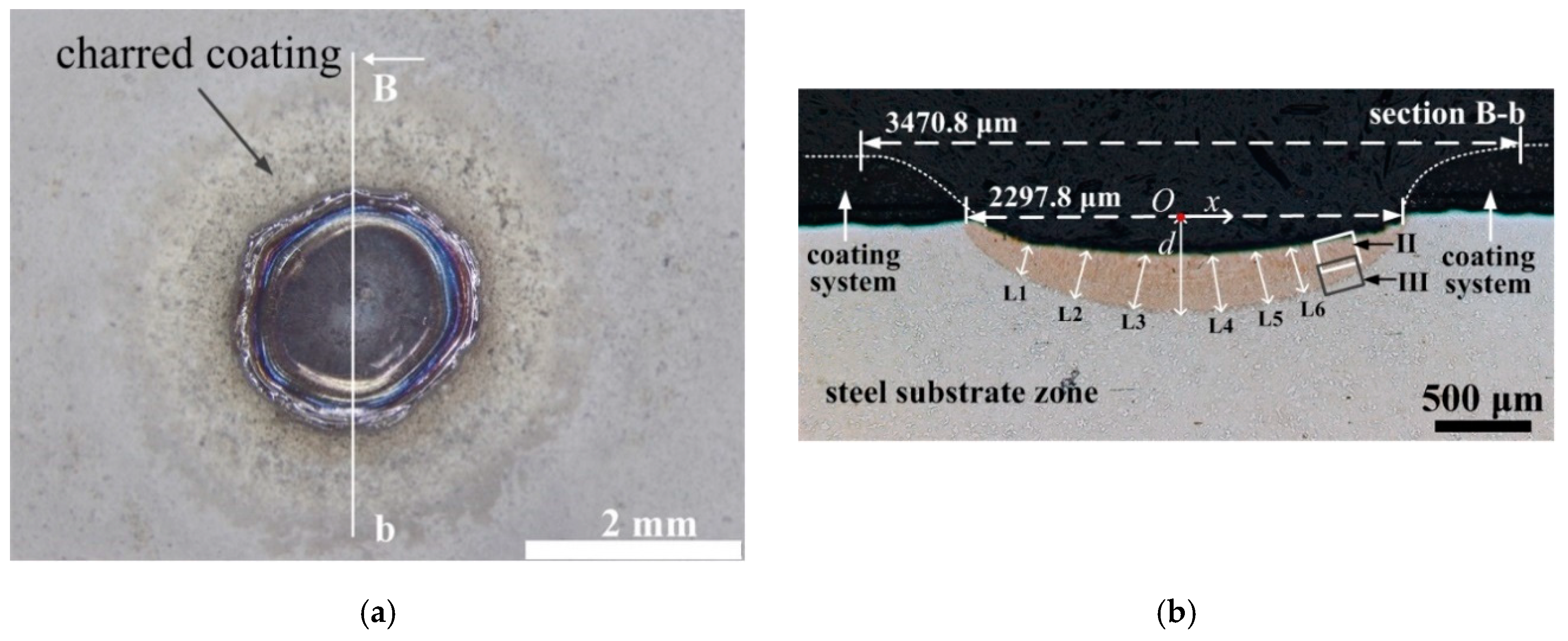
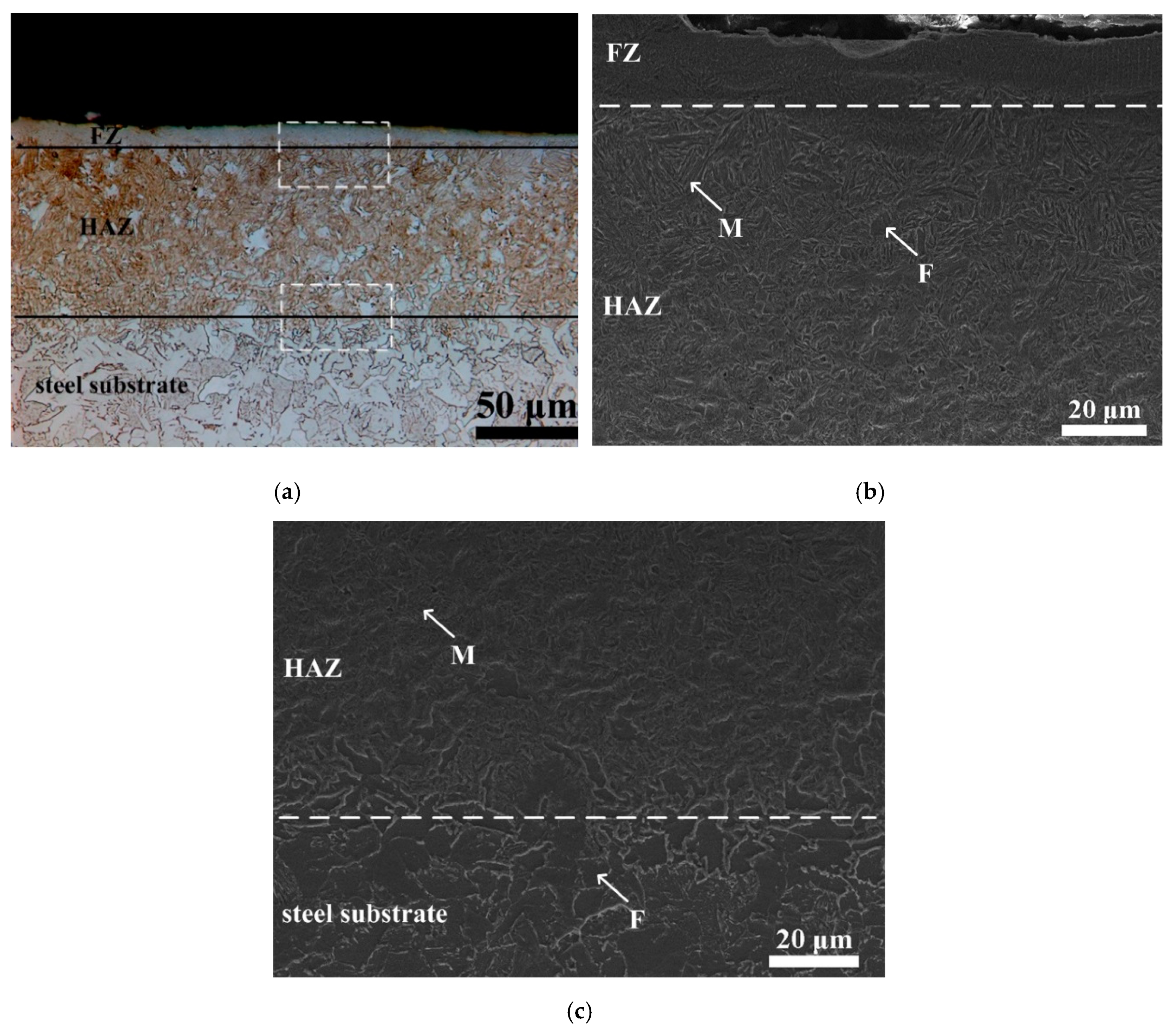
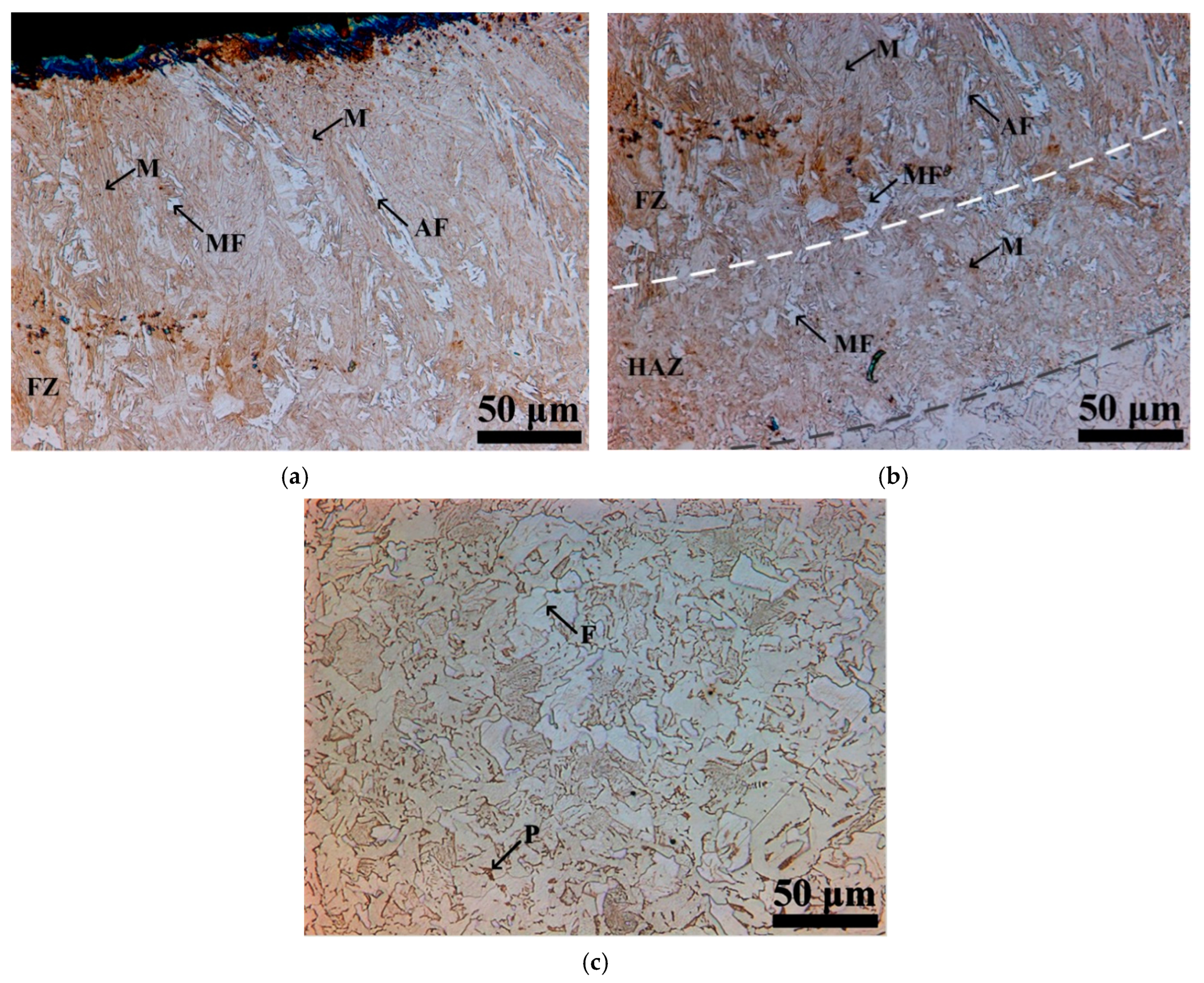
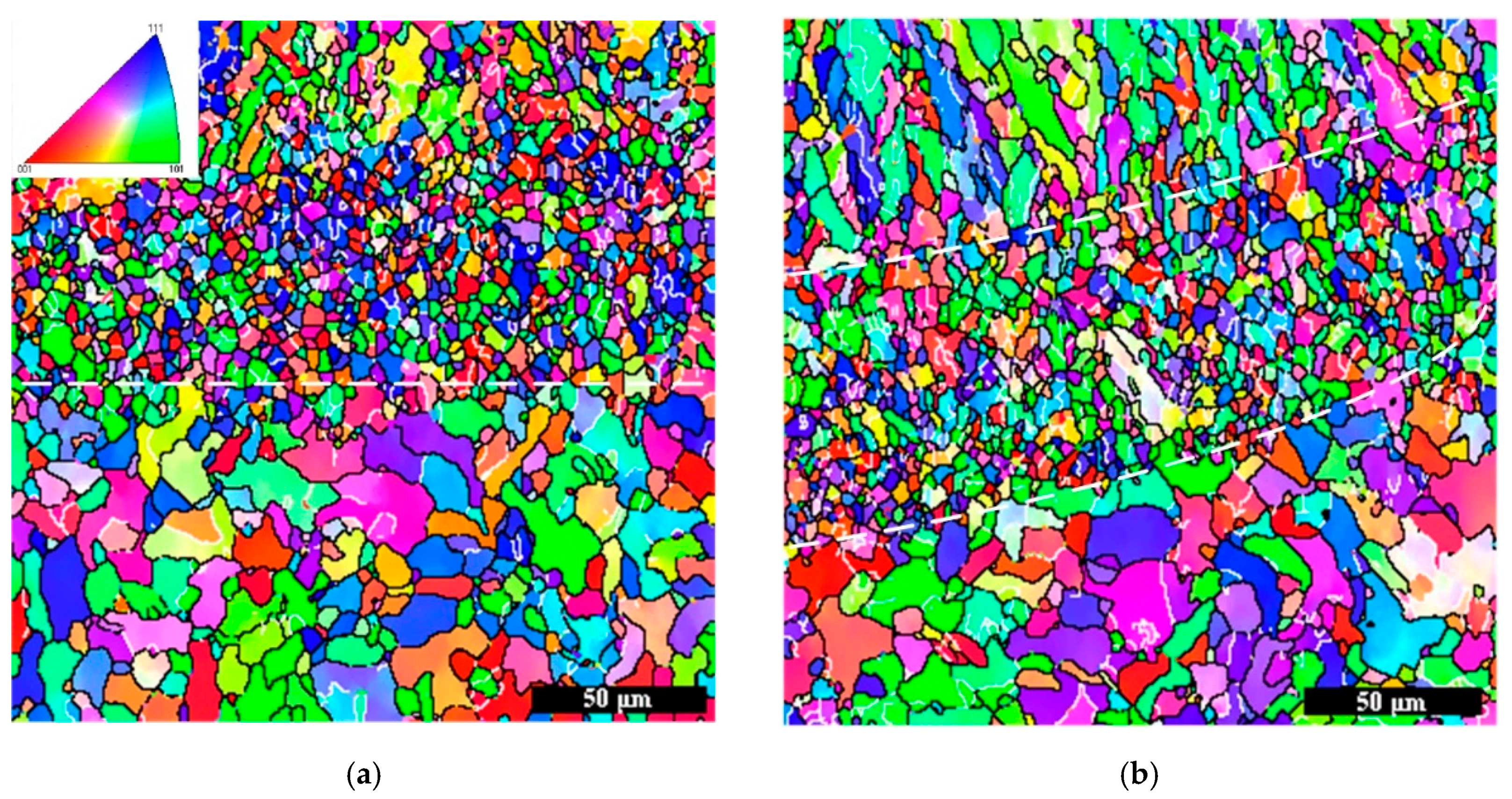
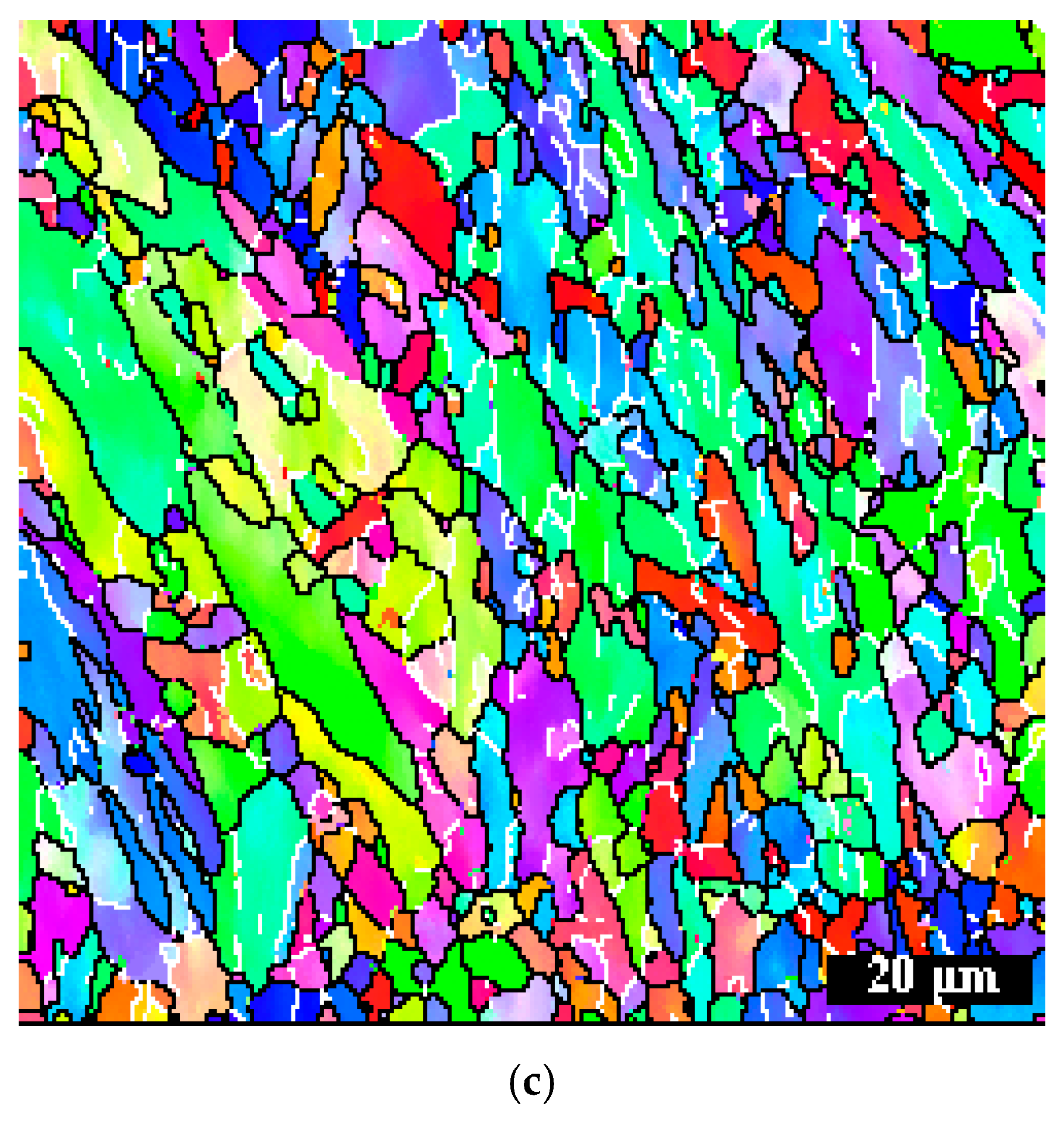

| Location | 1 | 2 | 3 | 4 | 5 | 6 |
|---|---|---|---|---|---|---|
| Uncoated | 63.3 | 120.3 | 75.9 | 75.9 | 114.1 | 76.2 |
| Coated | 156.6 | 237.4 | 285.7 | 290.0 | 263.7 | 240.0 |
| Zones | CGZ | FEGZ-II | FEGZ-I | Substrate |
|---|---|---|---|---|
| LAGBs fraction (%) | 60.5 | 51.2 | 48.1 | 29.6 |
© 2019 by the authors. Licensee MDPI, Basel, Switzerland. This article is an open access article distributed under the terms and conditions of the Creative Commons Attribution (CC BY) license (http://creativecommons.org/licenses/by/4.0/).
Share and Cite
Dai, M.; Liu, Y.; Fu, Z.; Liu, J.; Bi, X. Comparative Investigation on the Ablation of Uncoated and Coated Mild Steel Inflicted by the 2 ms 2 kA Rectangular Current. Metals 2019, 9, 150. https://doi.org/10.3390/met9020150
Dai M, Liu Y, Fu Z, Liu J, Bi X. Comparative Investigation on the Ablation of Uncoated and Coated Mild Steel Inflicted by the 2 ms 2 kA Rectangular Current. Metals. 2019; 9(2):150. https://doi.org/10.3390/met9020150
Chicago/Turabian StyleDai, Mingqiu, Yakun Liu, Zhengcai Fu, Juan Liu, and Xiaolei Bi. 2019. "Comparative Investigation on the Ablation of Uncoated and Coated Mild Steel Inflicted by the 2 ms 2 kA Rectangular Current" Metals 9, no. 2: 150. https://doi.org/10.3390/met9020150
APA StyleDai, M., Liu, Y., Fu, Z., Liu, J., & Bi, X. (2019). Comparative Investigation on the Ablation of Uncoated and Coated Mild Steel Inflicted by the 2 ms 2 kA Rectangular Current. Metals, 9(2), 150. https://doi.org/10.3390/met9020150





